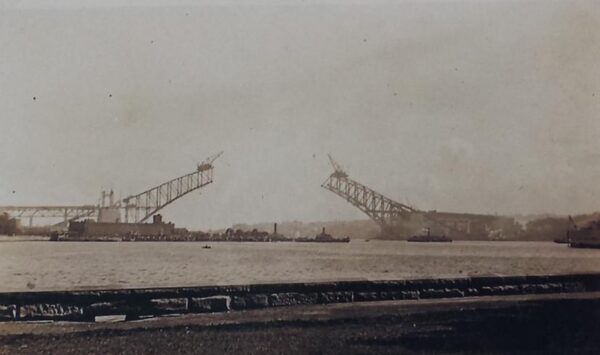Journey through time as the Bridge turns 90 – (includes a quote by Sydney University engineer and bridge expert Professor Wije Ariyaratne)
Source:news.com.au
A birthday extravaganza like no other is taking place this weekend as Sydney Harbour Bridge celebrates its 90th birthday.
On Saturday, Sydneysiders will mark the anniversary of the iconic site’s opening in 1932 with a series of free concerts, pop-up art galleries and installations.
In a special tribute, the pylons, upper and inner arches and under the road deck will light up over four nights, showcasing the bridge’s history.
In a nod to the bridge’s early history, Sydney will take a step back in time as vintage transport, including an original train carriage from the bridge’s opening, cross the railway.
Historic double-decker buses will operate from North Sydney and Wynyard while vintage ferries run between Milsons Point and Campbells Cove.
The BridgeClimb is offering discounted birthday climbs, allowing participants to join the more than four million customers who have climbed the arch since the company’s opening in 1998.
For some, the anniversary will be particularly sentimental.
Betty Thompson was eight-years-old when she witnessed the bridge’s opening.
Now 98, Ms White recalls the excitement that filled the air as more than one million people crossed the bridge for the first time.
“I remember it being a big walk and seeing children everywhere”, she said. “Not many people can say they have seen such an iconic moment in their lives.”
Built at the height of the Great Depression, the bridge was a beacon of hope for many who would otherwise be unemployed.
Over the course of its eight-year construction, the bridge employed 1,400 workers, at a cost of more than 10 billion pounds.
Ms Thompson said after two years of Covid-19 disruptions, it was fitting the bridge was once again reuniting people, just as it did 90 years ago.
Her observation is a testament to the work of engineer John Bradfield, who designed the bridge to connect communities, boost the economy and future-proof the city. Sydney University engineer and bridge expert Professor Wije Ariyaratne said, “Bradfield’s design was the beginning of today’s Sydney”.
“John Bradfield was a visionary and a futurist. He didn’t design for his day – he designed for the future and for all of us. No one had a greater impact on this city,” said Prof Ariyaratne.
Sydney Harbour Bridge: Celebrating 90 years of an Australian icon
Source: 7 News
It started as a way to connect two sides of Sydney Harbour but, over 90 years, has become an iconic part of visiting Australia.
It’s an icon of Australia and a beacon to tourists around the world.
The Sydney Harbour Bridge is celebrating 90 years since it opened to the public on March 19, 1932.
See the Sydney Harbour Bridge’s history come to life in the video above
It’s been described as a wonder of engineering, built for 6.25 million pounds in the currency of the day – nearly twice the original estimate.
Today, about 160,000 vehicles and 480 trains cross the bridge daily.
But it was some 130 years in the making before the first person crossed the bridge.
A bridge through time
Dr Ian Hoskins is an historian and the author of the book Sydney Harbour: A History.
He has written that the “first mention of a bridge across Sydney Harbour appeared in 1789, just a year after the First Fleet arrived”.
“Governor Arthur Phillip’s description of the harbour … in dispatches back to London inspired Erasmus Darwin to write a poem about the arrival of ‘hope’ on the other side of the world,” Dr Hoskins wrote.
“In an extraordinary bit of lucky prophecy, Darwin spoke of a ‘proud arch’ across the harbour.”
While a design for a single span bridge was drafted in 1857, there was no way it could have been achieved with the technology available at the time.
Over the next 50 years, there would be a number of different designs for a bridge.
One was from Dorman Long & Co and resembles Brisbane’s Story Bridge, while another design would have linked Balls Head, Miller’s Point and Balmain with a central tower on Goat Island.
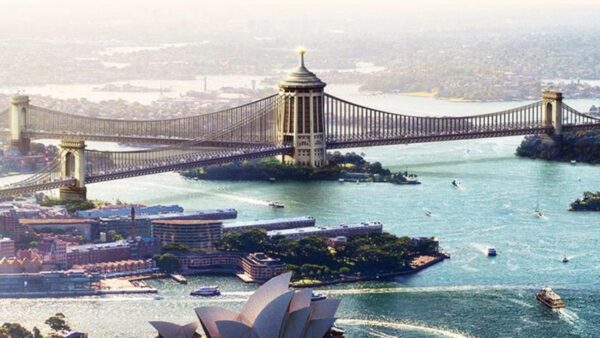
A rendering of F. Ernest Stowe’s design for the Sydney Harbour Bridge. Credit: Budget Direct
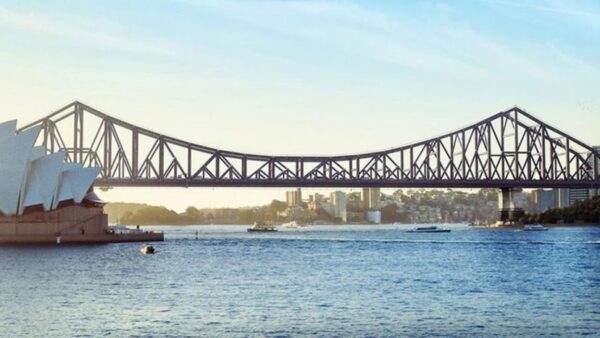
Dorman Long & Co. Ltd’s alternate design looks similar to Brisbane’s Story Bridge, which would open eight years later. Credit: Budget Direct
It wasn’t until John Bradfield was appointed Chief Engineer for the Sydney Harbour Bridge and City Transit in 1912 that plans started to firm up.
“John Bradfield was the key figure in pushing for the bridge that was finally built and the key person approving its design,” Hoskins said.
“The arch bridge that was finally decided upon in 1924 was designed by Ralph Freeman who worked for Dorman Long, the winners of the Bridge tender.”
In preparation for construction, the government resumed hundreds of commercial and residential properties on both sides of the harbour, affecting thousands of people.
The first sod was turned in 1923, then tonnes of stone steel were used to complete the project.
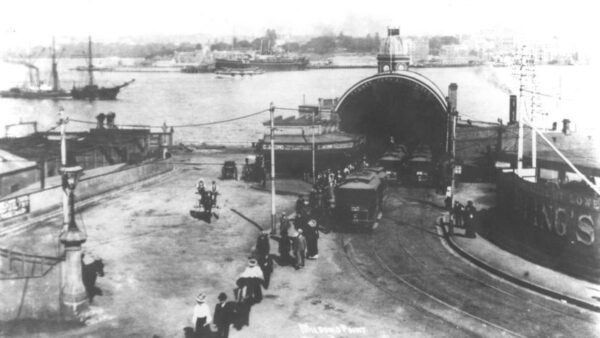
The beloved ferry arcade at Milson Point was a harbour landmark, demolished in 1926 to make way for the Sydney Harbour Bridge. Credit: Stanton Library
Jeremy Hards is Director of Roads Maintenance, Sydney Harbour Bridge and Precinct, at Transport for NSW.
“About 40 per cent of the steel supply was provided by BHP, so locally Australian manufactured,” says Mr Hards.
“The other 60 per cent was serviced from the UK, so there was a lot of logistics involved there.
“The granite blocks you see on the northern and southern pylons were all sourced from Moruya on the NSW south coast.”
An important part of the design was the single span, allowing ships to cross underneath unobstructed.
At the time, perfectly calculating – and joining – the arch was considered an extraordinary achievement.
Raymond Daly is Project Engineer, Sydney Harbour Bridge and Precinct, at Transport for NSW.
“They didn’t have the computer aided technology (or) the fancy surveying tools,” Mr Daly explained.
“But they managed to get that precise, spot on.”
According to Dr Hoskins, the arch was the first part of the bridge to be built.
“It was constructed from both sides so that the arch was joined in the middle,” he said.
“Once the arch was joined, the platform which would support the road, train and tram tracks could be built.”
Strikes and stop works
Over the next decade, 40,000 tonnes of steel and six million rivets would go into completing the Sydney Harbour Bridge.
But it wasn’t all smooth sailing.
“There were strikes and stop-works throughout the construction,” Hoskins remarked.
“Sixteen men died out of a workforce of 1,600 – itself remarkable given the absence of modern safety equipment.”
Then in March 1932, celebrations began in anticipation of the opening of the bridge
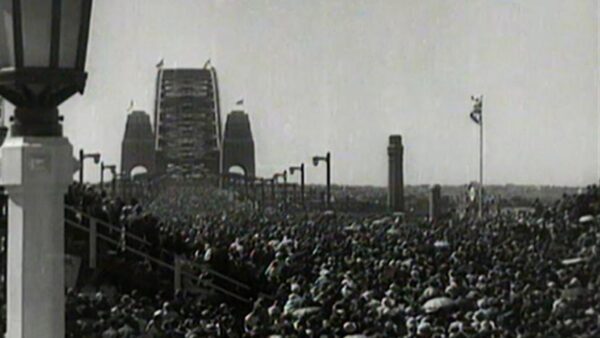
Thousands flock to the opening of the Sydney Harbour Bridge in 1932. Credit: Supplied
Fifty-two thousand school children were the first to walk across on March 16, ahead of the big day on March 19.
“There were two ribbons,” Hoskins said.
“One on the south side, officially cut by NSW Premier Jack Lang after the right-wing protester Francis De Groot slashed it with a sword, and another on the north side, cut by the North Sydney Mayor Hubert Primrose.”
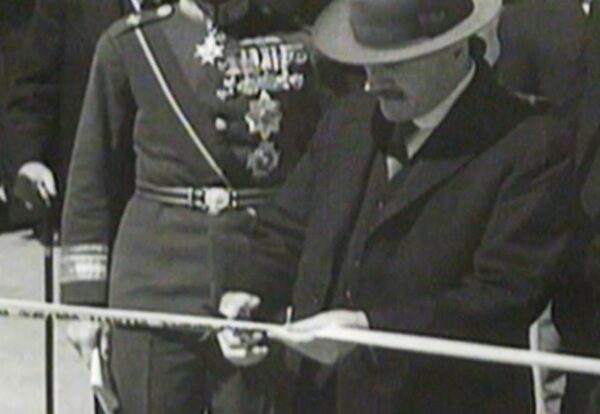
Premier of New South Wales, Jack Lang, opens the bridge by cutting a ribbon. Credit: Supplied
It’s estimated that 600,000 people – half of Sydney’s population at the time – turned out for one of the city’s biggest ever days.
Twenty-one thousand cars and 80,000 passengers then crossed the bridge the day after it opened, with more than 1.1 million vehicles using it in the first three months.
It also became Australia’s first toll bridge – something the then premier, Jack Lang, announced only three days before the opening.
Taking a toll
Crossing the bridge in 1932 cost six pence for a car (roughly equivalent to today’s $2.57), plus another six pence per adult passenger, or three pence per child.
Bikes and motorcycles were charged three pence ($1.28), while heavier vehicles had to pay between two and three shillings ($10.26 – $15.40).
For the first six months, toll collectors had no shelter – standing on the bridge in rain, hail or shine to take up money.
In June 1934, canopies were erected to help protect toll staff from the weather.
It wasn’t until 1949 that the familiar toll booths were installed.
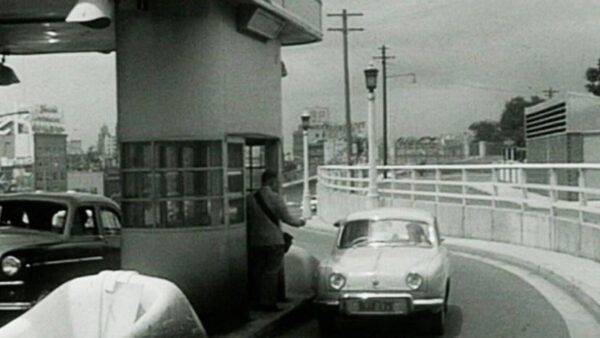
The first permanent toll booths on the Sydney Harbour Bridge. Credit: Supplied
In July 1970, one-way tolling was introduced, with tolls then collected only from southbound traffic.
In 1993, the Sydney Harbour Bridge began the first trial of electronic toll collection in Australia, using 1,000 tags and six toll lane ‘readers’.
The trial was deemed a success, more than doubling the number of cars that could pass through toll booths per hour.
Over the next six years, 30,000 electronic tags were issued.
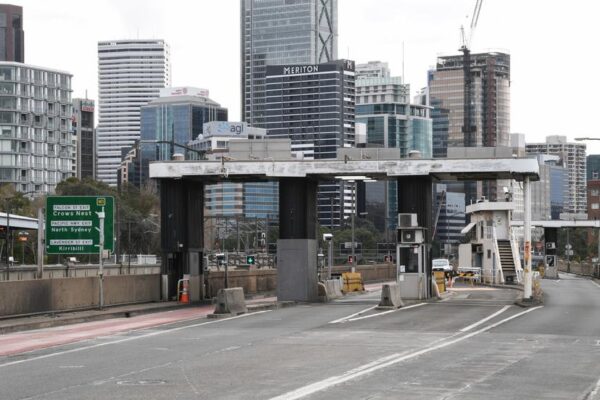
Work to remove the out of service toll booths at the Kirribilli end of the Sydney Harbour Bridge began in 2020. Credit: James D. Morgan/Getty Images
From January 11, 2009, the bridge became cashless, leaving the imposing toll booths empty and obsolete.
“Traffic greatly improved,” Transport for NSW’s Raymond Daly said.
“So you didn’t have that constant stop, start, stop to put money in or, later on, the e-tag, but it fixed a lot of the lane-filtering issues.”
in 2017, the southern toll booths were removed, followed by the northern booths in 2020.
It takes a village
There’s no doubt the Sydney Harbour Bridge is an icon, so it’s no surprise it’s heritage listed.
But did you know the colour of the bridge is also heritage listed?
“Sydney Harbour Bridge grey – it’s actually called that,” said Transport’s Jeremy Hards.
“You can’t buy it anywhere, it’s not on any colour chart.
“ It’s a special paint that’s only made by one supplier.”
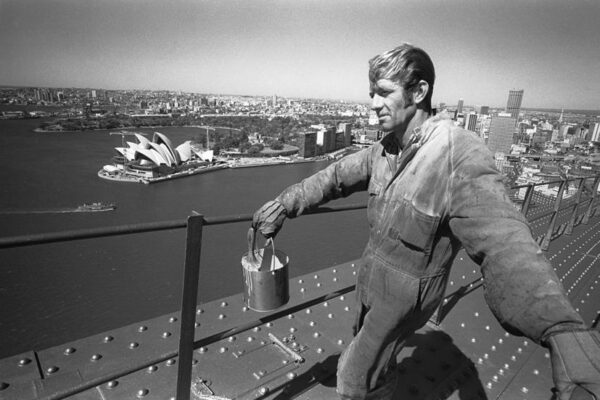
Paul Hogan working on the Sydney Harbour Bridge 1971. Credit: John Carnemolla/Corbis via Getty Images
Repainting the iconic bridge is by no means quick.
“There’s 485,000 square metres of steel that needs painting, so it takes a bit of time – give or take about 30 odd years if we hit our meterage targets.”
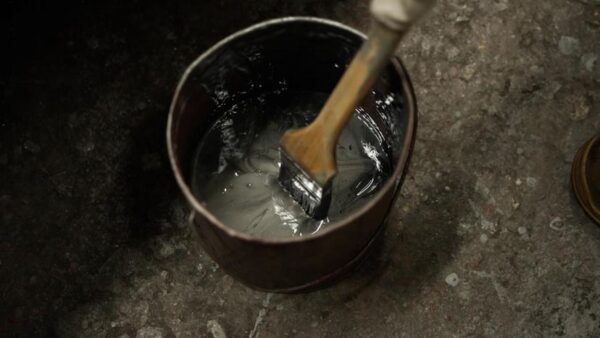
Sydney Harbour Bridge grey is unique and heritage listed. Credit: Transport for NSW
About 120 people work full-time on the structure, including around 100 painters, riggers, electricians, fitters, metal fabricators and engineers.
Iconic Aussie actor Paul Hogan famously worked on the bridge in the early 1970s.
“There’s 4,500 individual elements that we we’ve broken the bridge into and each one of those elements gets inspected at least once every two years,” Mr Hards said.
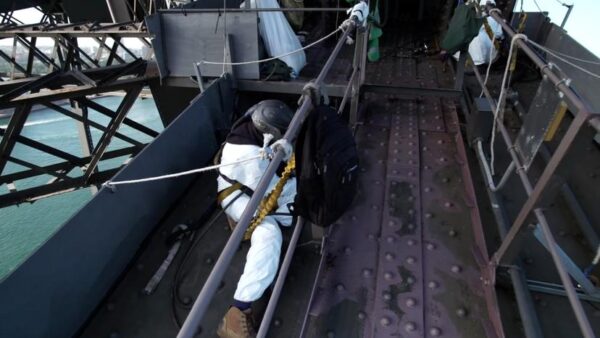
Crews conducting maintenance work on the Sydney Harbour Bridge. Credit: Transport for NSW
So after all this time, does the bridge still have a lot of life left in it?
“It’s well and truly over-engineered,” Mr Hards said.
“The amount of traffic that it carries now – the modern trains that we have, the trucks that cross the bridge – by no means have we exceeded limits of the bridge capability.”
On the map
As well as being a vital piece of infrastructure, the Sydney Harbour Bridge has become a popular destination for domestic and international tourists.
Every year, the world watches on as Australia is one of the first cities to ring in the new year, heralded by an epic fireworks display with the bridge at the centre.
As well as taking in the water views and enjoying the restaurants and bars around the harbour, tourists can even climb the bridge to see the view from the top.
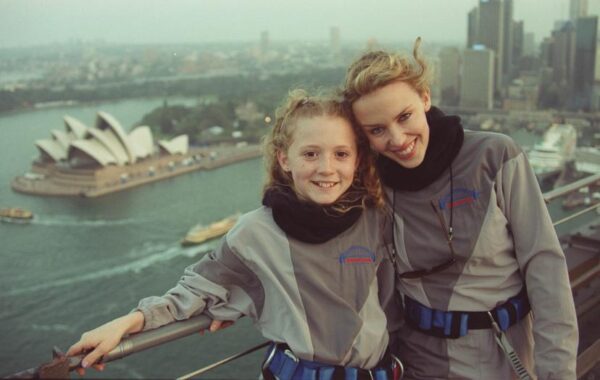
Nikki Webster and Kylie Minogue on top of the Sydney Harbour Bridge in 2000. Credit: GRANT WILSON/AP
BridgeClimb was founded by Paul Cave in 1998 and more than four million people have now ascended the famous structure.
“People really do see this as the heart of Sydney,” said Deb Zimmer, CEO of BridgeClimb.
“When [people] watch the New Year’s Eve fireworks … it’s something that you always want to see.”
Over the past 24 years, some famous faces have made their way up the bridge.
“Oprah Winfrey was one of the bigger ones (and) Prince Harry,” Zimmer said.
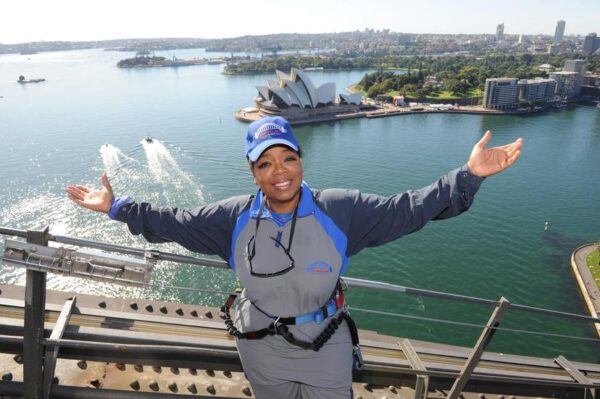
Oprah Winfey climbs the Sydney Harbour Bridge with members of her audience on May 13, 2010 in Sydney, Australia. Oprah was in town to record an episode of her hit TV show.
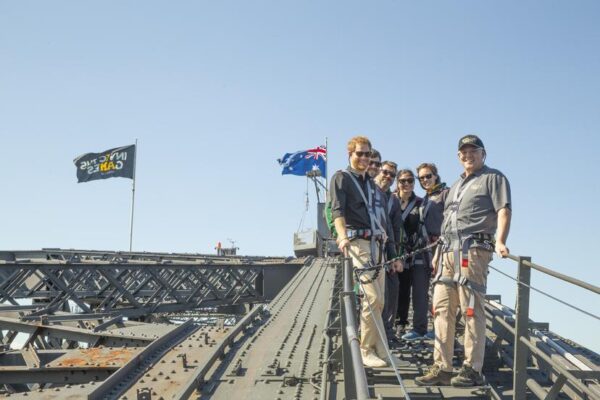
Britain’s Prince Harry, Australia’s Prime Minister Scott Morrison and Invictus Games representatives climb the Sydney Harbour Bridge in Sydney, Friday, October 19, 2018. The Duke and Duchess are on a tour to Australia, Fiji, Tonga and New Zealand. (AP Photo/Steve Christo, Pool)
BridgeClimb has also recently launched the Burrawa climb, an Indigenous storytelling experience.
“We launched this with the blessing of quite a few of the key Aboriginal people in Sydney.
“They’ve been amazing, giving us all these stories, their perspective from the top of the bridge and what all these moments mean to them.”
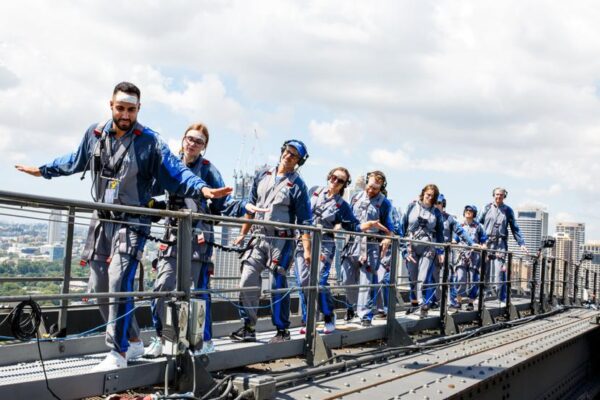
Visitors on BridgeClimb’s Burrawa climb. Credit: Supplied
‘Defining Sydney’
It’s hard to know where Sydney would be today without the harbour bridge as we know it.
“The bridge defined Sydney and indeed Australia,” Ian Hoskins said.
“It changed the scale of Sydney Harbour – it made it smaller visually, simply by its sheer size.
“But it also connected north and south and thereby diminished the separation of the two parts of the city.”
For Deb Zimmer, the bridge is a way to sell Sydney and Australia to the world.
“It really is a drawcard – we are just talking about shooting the latest Tourism Australia ad,” she said.


